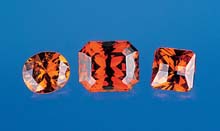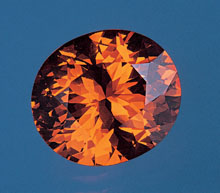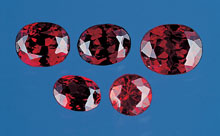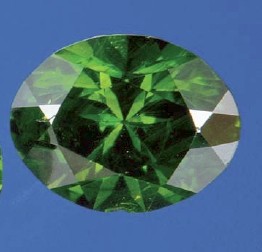The Many-Colored Garnet
Many people imagine a dark red colored stone when they think of garnet, but beyond the
well-known deep reds, garnet can be purchased in cinnamon to tangerine shades orange,
light yellows, deep purple, grass greens and soft bluish-pink. Garnet is all these colors
and many more. Garnets are actually a closely related group of different gemstones that
are available in nearly every color. There are garnets that change color in different
light, translucent green garnets that look like jade and garnets with stars. Some kinds of
garnets have been mined for thousands of years and some garnets were just discovered in
the last decade. Garnets are fairly hard and durable gemstones that are ideal for jewelry
use, except for demantoid, which is softer and requires more protection. Because some
garnets are inexpensive and have been used in the past for cheap jewelry, garnet is the
gemstone which just doesn’t seem to get the “respect” it is due. This is
rapidly changing in light of the many new varieties of stunning colors now available in
Garnet gems.
Garnets have been used as
ornamentation for more than 5,000 years. Garnet beads have been found in Egyptian
excavations dating back to 3200 B.C. The breastplate of Aaron, which was worn around 2,000
B.C., is said to have contained a Garnet. The Asians in the 4th century B.C. used Garnets
in creating their seals. Frequently Garnets were carved into cameos and intaglios and worn
in rings. Carbuncle is an old term which typically referred to a Cabochon Garnet. The back
of the Cab was hollowed out to create a brighter Garnet and make it more transparent.
The Garnet group of minerals has 20 different species. The most commonly recognized are
Pyrope, Almandite, Spessartite, Grossular and Andradite. The chemical formula for Garnet
is complex with all species having a slightly different combination of elements. During
crystallization some elements interchange to form a mixed Garnet consisting of two or more
different species. Pyrope-Almandite, Almandite-Spessartite and Pyrope-Spessartite are
examples of these types of intergrowth. Garnets have a hardness of 6.5-7.5 and are
excellent choices for jewelry. Garnet crystals form in the cubic system, typically as a
12-sided crystal or dodecahedron. They are available in all colors except pure Blue. One
problem with some types of garnets comes from their deeply saturated color. In many types
of garnet, especially Pyrope and some Almandines, gems cut into large sizes will be too
dark to reflect light and and the stones will appear black. It is important to consider
this fact when buying larger deep colored garnets. In general, garnets are not treated to
change their color, in the way that many other gems are.
Popular Varieties of Garnet Include:
Almandine is
perhaps the most common of the garnet family, and is the deep red to red-brown stone most
often thought of when people think of garnet. It is an inexpensive stone, but new mines in
east Africa are producing Almandine in more desirable red to red-orange colors which have
no brown undertones. The major sources of Almandine are Madagascar, India and Sri Lanka.
Almandines are sometimes
available in large sizes, and most garnet sculptures are done in Almandine. Entire cups or
vases have been made from single crystals. Because of its depth of color and saturation,
some faceted gems cut too large from this deeply colored material will not sparkle because
they are too dark to reflect the light.
Rhodolite is
the name used to describe the lovely pinkish, purplish or lavender Red Garnets which are a
mixture of Almandite and Pyrope. This name was first used in the late 1800's to describe
the new rhododendron shade of Garnets discovered in North Carolina. In general,
Rhodolite
Garnets are not as dark as the common Pyrope or Almandine Garnets. Most Rhodolites seen today are African in origin and
are bright, transparent Gems. These are probably the most popular garnet seen in fine
jewelry today. Common shades of Rhodolite include Red stones, purplish Red and the popular
Raspberry Rhodolite, a rich red-Purple with
bright Lavender highlights. Rhodolite garnet is mined in Africa, India, and Sri Lanka.
Brazil is producing a dark purplish Rhodolite, sometimes called grape garnet, because of
its similarity of color to concord grape jam.

Pink Rhodolite Garnets
Malaya garnet, another popular mixed
variety, ranges from orange to gold and is mined in Tanzania and Kenya. Gem diggers
working the stream gravels nearly a decade ago found lovely orange and beige colored
garnets in much larger pieces. The color led these miners to believe that they had found a
deposit of Spessartite garnet. It turned out that it was a mixture of different garnet
species. When the true identity was determined, they gave this new and unique material the
name "Malaya", which, in Swahili, means "deceiver". This name has been
used by the gemstone trade ever since.
The color of
Malaya ranges from dark orange to beige-orange, and (rarely) a peachy-cinnamon color that
is one of the loveliest and most unusual in the gem kingdom. Stones over 5 carats are rare, and the largest Malays on record are under 100
carats. Lighter tones are considered more desirable, and true pinks are among the rarest
of all garnets, regardless of hue.
Grossular
- is found in a wide range of hues ranging from colorless to shades of pink, orange,
yellow and green. These rare and beautiful gemstones are found at only a few localities on
earth, and seldom in large sizes. One of the principal occurrences is in the Umba River
Valley, in northern Tanzania. Colorless, pink and yellow grossulars are, if free of
internal imperfections, virtually nonexistent in sizes over 5 carats. Tanzania also
produces a fine orange colored Grossular. Orange-brown Grossular is known as hessionite.
A beautiful
orange pink Grossular garnet has been obtained from an asbestos mine in Canada.
Unfortunately many of these gems are flawed, and larger clean garnets from this deposit
are both rare and beautiful.

Orange Grossular Garnet
Spessartite
Spessartite
Garnets are commonly seen in bright shades of intense Orange or reddish Orange. One type
of Spessartite garnet growing in popularity is a newly discovered garnet from Namibia,
which is a bright orange shade of Spessartite. It is called mandarin garnet because of its
true orange color. A beautiful orange colored Spessartite garnet is found near Ramona in
San Diego County, California, but this rare garnet has also been mined in
Brazil and a few locations in Africa. Truly clean bright orange Spessartite garnets are unusual,
especially in sizes over 5 carats. Most have at least minor inclusions. The darker reddish
orange stones are generally cleaner and commonly larger in size.

Orange Spessartite Garnet
Pyrope
Pyrope
garnet is a very saturated red: beautiful small Pyrope garnets found in Arizona are called
anthill garnet because they are mined by ants, who carry them up when they are excavating
their anthills. The red of Pyrope is the truest red and in smaller sizes it is the closest
to ruby in color. This is true because both the ruby and the Pyrope garnet are colored by
the element Chromium. However, some gems cut too large from this deeply colored material
will not sparkle because they are too dark to reflect the light. Most Pyrope is best cut
in sizes of no more than about a carat. Pyrope garnets sometimes form in the same deposits
as diamonds.

Deep Red Pyrope Garnets
Tsavorite
Tsavorite is the most desirable of
all garnets, with a wonderful purity and intensity of its beautiful green color. Until
Tsavorite was discovered in the late 1960's there was no other gemstone but emerald that
could offer the gem buyer such a rich, dark green color. This magnificent green garnet has been in great
demand for jewelry since its discovery, and for good reasons: it is harder than emerald,
more durable in jewelry, less included than emerald, more brilliant when faceted, and is
much rarer than emerald. In short, it is (by all counts) a better gemstone, but it lacks
the magic and the antiquity of the name "emerald". For this reason it is known
to far fewer people, is in much lower demand, and is therefore much less expensive than
emerald of comparable color. Even so, because of its beauty, Tsavorite is the most
expensive of the garnet family. It is actually a form of Grossular, colored green by the
presence of trace amounts of the metal vanadium.
Hessonite
garnets, a variety of Grossular, come mostly in shades of orange-brown colors and are
sometimes called cinnamon garnets. Although fairly inexpensive, they are not often seen in
modern jewelry.
With its beautiful green color, for many years the queen of the garnet family was the Demantoid garnet, which was discovered in Russia's Ural Mountains in 1868. Though bright and attractive, Demantoid was available mostly only in small sizes. Mining of this beautiful, brilliant green garnet lasted only about 30 years and was completed by the turn of the last century. Today the only source for top quality stones is antique jewelry. The Demantoid garnet is a variety of Andradite. Adradite has a high level of optical dispersion, causing rainbow colored reflections which are seen in diamond.
In 1994, in the country of Mali, Africa, a unique yellow-green to yellow brown garnet was discovered. It is principally adradite, mixed with some Grossular. Occasionally specimens from this site are colored a deep green dematiod color. An iridescent Andradite garnet, showing a rainbow play of colors was mined from Mexico in the 1990s, and a similar iridescent Andradite material occurs in Nevada.

Color Change Garnet
Another mixed garnet species material mined at Tunduru gravels in east Africa shows a significant color change, some of the material going from Red to blue or from pink to green colors when going from outdoor to indoor lighting. Some color change garnet comes from Madagascar as well. This material is quite rare, and usually fairly expensive for a garnet.
